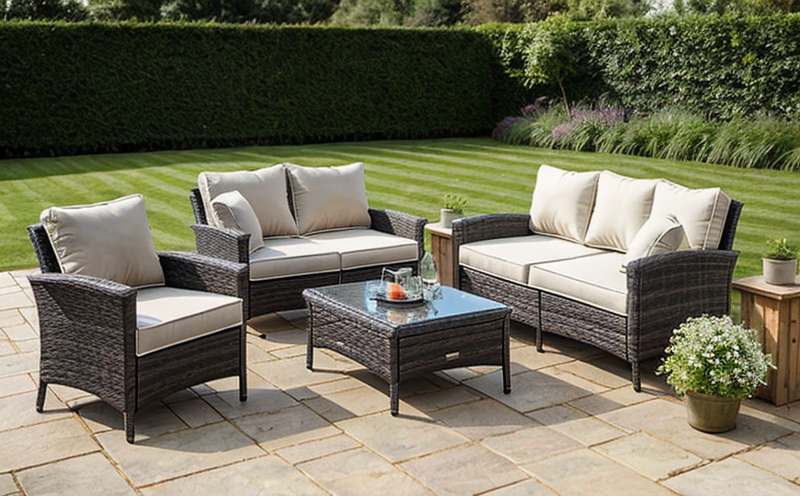ASTM D2247 Humidity Resistance of Outdoor Furniture Coatings Testing
The ASTM D2247 test method is a critical standard used to determine the humidity resistance of coatings applied to outdoor furniture. This testing ensures that the finishes and materials used in manufacturing outdoor furniture can withstand prolonged exposure to moisture, which is essential for durability and longevity.
Outdoor furniture, such as garden benches, tables, chairs, and other similar items, are subjected to various environmental conditions, including humidity, rain, dew, and varying temperature fluctuations. These factors can significantly impact the performance of the coatings used on outdoor furniture over time. The ASTM D2247 test simulates these real-world conditions by exposing coated samples to a controlled environment with high relative humidity levels.
The primary goal of this testing is to evaluate how well the coating resists degradation due to moisture and other environmental factors that can lead to chalking, cracking, or flaking. The test helps manufacturers ensure their products meet quality and durability standards, thereby enhancing customer satisfaction and product longevity.
During the ASTM D2247 test, coated specimens are exposed to a humid environment for a specified duration, typically up to 168 hours (one week). After exposure, the samples undergo a series of visual inspections and measurements. The visual inspection checks for any signs of degradation such as discoloration, chalking, cracking, or flaking. These observations provide valuable insights into the performance of the coating under humid conditions.
Specimen preparation is crucial in ensuring accurate test results. Coated specimens should be prepared according to ASTM D2247 guidelines. This includes selecting appropriate sample sizes and shapes that are representative of the actual furniture components being tested. The samples must also be cleaned thoroughly before exposure to prevent any contamination from affecting the outcome.
The testing apparatus used in this process typically consists of a humidity chamber capable of maintaining precise temperature and relative humidity levels. The chamber should allow for easy observation and access to the specimens during the test period. Additionally, specialized equipment may be required to measure changes in properties such as adhesion strength or color change before and after exposure.
After completing the exposure phase, detailed analysis is conducted on each specimen. This involves both qualitative assessments like visual inspections and quantitative evaluations involving measurements of physical property changes. Reporting the results accurately according to ASTM D2247 specifications allows for clear communication among stakeholders involved in product development and quality assurance.
This testing procedure plays a vital role not only within the furniture industry but also across related sectors such as home improvement stores, retail outlets specializing in garden furnishings, and manufacturers who produce similar products. By adhering to this standard, companies can demonstrate their commitment to producing high-quality outdoor furniture that stands up against harsh environmental conditions.
It's important for quality managers, compliance officers, R&D engineers, and procurement personnel within these organizations to understand the significance of ASTM D2247 testing. Understanding how to properly prepare specimens, operate the necessary equipment, interpret results correctly, and implement findings effectively contributes significantly towards improving overall product performance.
Applied Standards
- American Society for Testing and Materials (ASTM) D2247-18 Standard Practice for Humidity Resistance of Coatings Used on Outdoor Furniture
- International Organization for Standardization (ISO)
- European Committee for Standardization (CEN)
The ASTM D2247 test method is widely recognized and utilized globally as a definitive standard for assessing the humidity resistance of coatings employed on outdoor furniture. This aligns closely with other international standards from organizations like ISO and CEN, further emphasizing its importance in maintaining consistent quality across different regions.
Benefits
The primary benefit of conducting ASTM D2247 testing is ensuring that coatings used on outdoor furniture are capable of withstanding harsh environmental conditions. By identifying any deficiencies early in the production process, manufacturers can make necessary adjustments to improve product performance.
- Enhanced Durability: Ensures longer-lasting products by preventing premature failure caused by moisture exposure.
- Better Customer Satisfaction: Provides peace of mind for consumers knowing they are purchasing durable, high-quality furniture.
- Informed Decision Making: Offers valuable data points that guide R&D efforts towards developing more resilient coatings.
Overall, compliance with ASTM D2247 helps businesses stay competitive by offering superior products that meet or exceed industry expectations. It also supports regulatory requirements and contributes positively to brand reputation.
International Acceptance and Recognition
- Australia: Standards Australia (AS) equivalent test methods are used in parallel with ASTM D2247, ensuring consistency across international markets.
- New Zealand: Recognizes the relevance of ASTM D2247 in its own national standards, facilitating easier trade between countries.
- United Kingdom: Incorporates ASTM D2247 into its British Standards (BS), promoting global harmonization and interoperability.
- European Union: The European Committee for Standardization (CEN) aligns with ASTM D2247, creating a unified approach across member states.
The widespread acceptance of ASTM D2247 demonstrates its importance in the global market. By adhering to this standard, manufacturers can ensure their products meet international quality and durability standards, opening up opportunities for broader distribution and customer trust.





